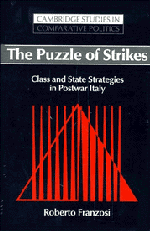Book contents
- Frontmatter
- Contents
- List of tables, figures, and equations
- Dedication
- Preface
- Acknowledgments
- 1 The puzzle box
- 2 Labor-market conditions and bargaining power
- 3 When do workers strike? How the economy matters
- 4 Organizational resources and collective action
- 5 The structure of collective bargaining
- 6 Class power, politics, and conflict
- 7 Mobilization processes: the 1969 autunno caldo
- 8 Countermobilization processes: reactions by the state and employers to strike waves
- 9 The picture in the puzzle
- Epilogue
- Appendix: the data
- Notes
- Bibliography
- Index
1 - The puzzle box
Published online by Cambridge University Press: 08 January 2010
- Frontmatter
- Contents
- List of tables, figures, and equations
- Dedication
- Preface
- Acknowledgments
- 1 The puzzle box
- 2 Labor-market conditions and bargaining power
- 3 When do workers strike? How the economy matters
- 4 Organizational resources and collective action
- 5 The structure of collective bargaining
- 6 Class power, politics, and conflict
- 7 Mobilization processes: the 1969 autunno caldo
- 8 Countermobilization processes: reactions by the state and employers to strike waves
- 9 The picture in the puzzle
- Epilogue
- Appendix: the data
- Notes
- Bibliography
- Index
Summary
Strikes … always instil fear into the capitalists, because they begin to undermine their supremacy. … Every strike brings thoughts of socialism very forcibly to the worker's mind, thoughts of the struggle of the entire working class for emancipation from the oppression of capital.
V.I. Lenin (quoted in Clarke and Clements, 1977, pp. 58–9)We have no intention whatever of doubting or despising the “revelation of history,” for history is all and everything to us.
Friedrich Engels (Lapides, 1987, p. xviii)Without use of history and without an historical sense of psychological matters, the social scientist cannot adequately state the kind of problems that ought now to be the orienting points of his studies.
Mills (1959, p. 143)Exploratory data analysis can never be the whole story, but nothing else can serve as the foundation stone – as the first step.
Tukey (1977, p. 3)WHY STRIKES? WHY ITALY?
It has been twenty years since Shorter and Tilly's Strikes in France: 1830–1968 and Pizzorno's Lotte operaie e sindacato in Italia: 1968–1972 were published – two books unsurpassed in the strike literature, even as the levels of industrial conflict reached during the turbulent 1960s remain unsurpassed, and not only in France and Italy. The 1960s saw a great resurgence of conflict across a range of industrial nations, and with that renewed conflict came a revival of scholarly interest, as researchers began trying to make sense of what had happened. Just as eventful as the 1960s had been on the stage of historical reality, the 1970s saw the development of new theoretical approaches to the study of strikes.
- Type
- Chapter
- Information
- The Puzzle of StrikesClass and State Strategies in Postwar Italy, pp. 1 - 29Publisher: Cambridge University PressPrint publication year: 1995

